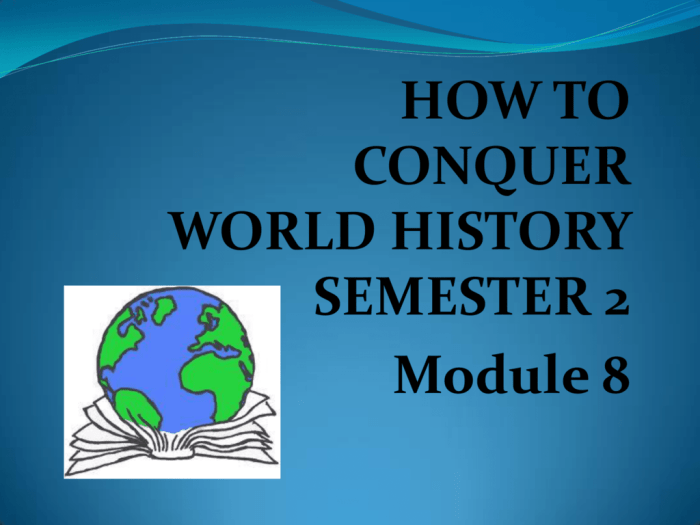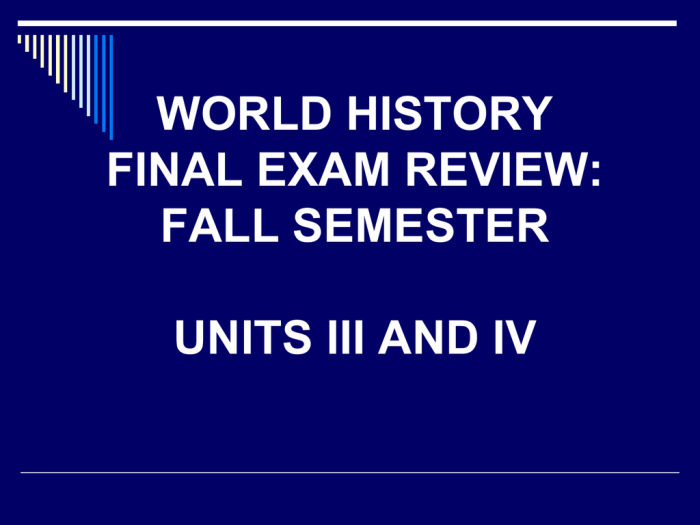Prepare for the World History Semester 2 Exam and dive into a captivating journey through time. This exam will test your knowledge of significant events, civilizations, and cultural transformations that have shaped the world we live in today.
From the rise and fall of empires to the transformative power of technology, this exam covers a vast canvas of human history. Get ready to explore the complexities of the past and gain insights that will empower you to understand the present and shape the future.
Historical Events and Developments

The second semester of world history witnessed a series of transformative events that shaped the course of human civilization. From the rise of empires to the spread of ideas, these events had profound consequences that continue to resonate today.
Timeline of Key Events
- 323 BCE: Death of Alexander the Great and the division of his empire
- 218-201 BCE: Second Punic War between Rome and Carthage
- 476 CE: Fall of the Western Roman Empire
- 622 CE: Hegira (migration) of the Prophet Muhammad from Mecca to Medina, marking the beginning of the Islamic calendar
- 1095-1099 CE: First Crusade
- 1215 CE: Signing of the Magna Carta, establishing the principle of limited government
- 1492 CE: Christopher Columbus’s arrival in the Americas
- 1517 CE: Martin Luther’s Ninety-Five Theses, sparking the Protestant Reformation
Causes and Consequences
These events were driven by a complex interplay of factors, including political ambition, economic pressures, and religious beliefs. Their consequences were equally far-reaching, transforming political systems, economic structures, and cultural landscapes.The death of Alexander the Great led to the fragmentation of his vast empire, paving the way for the rise of new powers in the Hellenistic world.
The Second Punic War established Rome as the dominant force in the Mediterranean region, while the fall of the Western Roman Empire marked the end of classical antiquity.The Hegira and subsequent spread of Islam had a profound impact on the Middle East and beyond, creating a new religious and political order.
The Crusades brought Europe into contact with the Islamic world, leading to both conflict and cultural exchange. The Magna Carta limited the power of the English monarchy, establishing a precedent for constitutional government.The arrival of Christopher Columbus in the Americas initiated the European colonization of the New World, with far-reaching consequences for both the indigenous peoples and the European powers involved.
The Protestant Reformation challenged the authority of the Catholic Church, leading to religious wars and the emergence of new denominations.
Impact on Human Civilization
These events shaped the political, economic, and cultural development of human civilization. They established the foundations of modern nation-states, influenced the spread of ideas and technologies, and set the stage for future global interactions. The legacy of these events continues to influence the world we live in today.
Major Civilizations and Empires

The second semester of world history witnessed the emergence and development of several prominent civilizations and empires that shaped the course of human history. These societies showcased diverse political, economic, and social structures, contributing to the rich tapestry of human civilization.
Mesopotamia
Mesopotamia, often referred to as the “Cradle of Civilization,” was home to the Sumerian, Babylonian, and Assyrian empires. These civilizations flourished in the fertile valleys of the Tigris and Euphrates rivers, developing sophisticated systems of writing, mathematics, and astronomy. Their political structures ranged from city-states to centralized empires, while their economies were based on agriculture and trade.
Ancient Egypt
Ancient Egypt, located along the Nile River, was another major civilization that left an enduring legacy. The Egyptian pharaohs ruled over a highly centralized and bureaucratic state, relying on a complex system of irrigation and agriculture to sustain their vast population.
Their monumental architecture, including the pyramids and temples, showcased their advanced engineering skills.
Indus Valley Civilization
The Indus Valley Civilization, located in present-day Pakistan and India, was a Bronze Age civilization that flourished between 2600 and 1900 BCE. Known for its advanced urban planning, sanitation systems, and standardized weights and measures, the Indus Valley Civilization exhibited a remarkable level of organization and sophistication.
Ancient Greece, World history semester 2 exam
Ancient Greece, centered on the Aegean Sea, was a major civilization that contributed significantly to Western thought and culture. The Greeks developed democratic city-states, such as Athens and Sparta, and made significant advancements in philosophy, literature, and the arts. Their military prowess and territorial expansion led to the rise of the Hellenistic world.
Roman Empire
The Roman Empire, spanning from the Mediterranean Sea to Western Europe, was one of the largest and most influential empires in history. The Romans established a vast network of roads, aqueducts, and public buildings, contributing to the spread of their culture and ideas.
Their legal system and political structures had a lasting impact on Western civilization.
Social and Cultural Changes
The second semester of world history witnessed a multitude of significant social and cultural transformations that profoundly shaped the development of human societies. These changes were driven by various factors, including technological advancements, economic shifts, and political ideologies, and had far-reaching consequences for social structures, cultural norms, and individual identities.
One of the most notable social changes during this period was the rise of industrialization, which led to a shift from agrarian to urban societies. As factories and industries sprang up, people began to migrate from rural areas to cities in search of employment.
This urbanization process had a profound impact on social structures, as it led to the formation of new social classes, the breakdown of traditional family structures, and the emergence of new forms of social organization.
Spread of Literacy
The spread of literacy was another major social change that occurred during the second semester of world history. With the advent of the printing press, books and other printed materials became more widely available, which led to an increase in literacy rates among the general population.
This, in turn, had a significant impact on cultural development, as it allowed for the dissemination of new ideas and the preservation of cultural heritage.
The world history semester 2 exam is just around the corner, and I’m starting to feel the pressure. I’ve been studying hard, but I can’t help but feel like I’m not prepared enough. I’ve been reading everything I can get my hands on, including parsley by rita dove analysis . I hope that by understanding the different perspectives on historical events, I’ll be better prepared for the exam.
Wish me luck!
Religious Reforms
Religious reforms also played a significant role in shaping social and cultural change during this period. The Protestant Reformation, which began in the 16th century, challenged the authority of the Catholic Church and led to the establishment of new Protestant denominations.
These religious divisions had a profound impact on European society, leading to religious wars and political conflicts.
Scientific Revolution
The Scientific Revolution, which began in the 17th century, marked a major turning point in the development of human knowledge. New scientific methods and discoveries challenged traditional beliefs and led to a new understanding of the natural world. This had a significant impact on cultural development, as it undermined traditional religious beliefs and paved the way for the development of modern science and technology.
Enlightenment
The Enlightenment, which took place in the 18th century, was a philosophical movement that emphasized reason and individualism. Enlightenment thinkers challenged traditional authority and advocated for the rights of the individual. These ideas had a profound impact on social and cultural change, as they laid the foundation for modern democratic societies.
The social and cultural changes that occurred during the second semester of world history were complex and far-reaching. These changes had a profound impact on the development of human societies and continue to shape our world today.
Technological Advancements

The second semester of world history witnessed remarkable technological advancements that transformed human civilization. These innovations had a profound impact on societies, shaping economies, communication, and warfare, while also raising ethical and social concerns.
The Industrial Revolution
- Steam engine: Revolutionized transportation, manufacturing, and agriculture, ushering in the Industrial Age.
- Spinning jenny and power loom: Automated textile production, leading to mass production and the rise of factory systems.
- Iron and steel production: Improved construction materials and tools, facilitating infrastructure development and industrialization.
Scientific Discoveries and Innovations
- Vaccination: Edward Jenner’s discovery prevented smallpox, reducing mortality rates and improving public health.
- Anesthesia: Pioneered by William Morton, it revolutionized surgery, reducing pain and increasing surgical success.
- Electromagnetism: Michael Faraday’s work laid the foundation for electricity generation and transmission, powering industries and cities.
Transportation and Communication
- Steam locomotive: Revolutionized land transportation, enabling faster and more efficient travel.
- Telegraph: Samuel Morse’s invention allowed for instant long-distance communication, transforming business and diplomacy.
- Photography: Louis Daguerre’s process captured moments in time, preserving history and advancing scientific research.
Ethical and Social Implications
- Child labor and working conditions: Industrialization led to widespread exploitation of child and adult laborers in factories.
- Urbanization and pollution: Rapid industrialization resulted in overcrowding, sanitation issues, and environmental degradation.
- Technological unemployment: Automation and mechanization displaced workers, raising concerns about job security.
Primary and Secondary Sources

Primary sources are firsthand accounts of historical events, such as letters, diaries, speeches, and artifacts. Secondary sources are interpretations of primary sources, such as textbooks, biographies, and documentaries.Primary sources provide direct evidence of the past, but they can be biased or incomplete.
Secondary sources can provide a more comprehensive view of the past, but they can also be biased by the author’s perspective.To construct a historical narrative, historians use both primary and secondary sources. They compare different sources to identify corroborating evidence and to assess the reliability of each source.
They also consider the context in which each source was created to understand its biases and limitations.
Strengths of Primary Sources
* Provide firsthand accounts of historical events
- Can be used to verify the accuracy of secondary sources
- Can provide insights into the thoughts and feelings of historical figures
Weaknesses of Primary Sources
* Can be biased or incomplete
- Can be difficult to interpret
- May not be available for all historical events
Strengths of Secondary Sources
* Provide a comprehensive view of the past
- Can be used to identify patterns and trends
- Can be used to interpret primary sources
Weaknesses of Secondary Sources
* Can be biased by the author’s perspective
- May not be based on reliable primary sources
- May not be up-to-date
Essential Questionnaire: World History Semester 2 Exam
What is the format of the World History Semester 2 Exam?
The exam typically consists of multiple-choice questions, short answer questions, and essay questions that cover the key topics Artikeld in the course.
How can I prepare effectively for the exam?
Thoroughly review your class notes, textbooks, and any additional resources provided by your instructor. Practice answering different types of questions and seek clarification on any concepts you find challenging.
What is the significance of studying world history?
Understanding world history provides a broader perspective on the human experience, fosters cultural awareness, and helps us learn from the successes and failures of past civilizations.